Written by Mengran Zhu
It seems that every city with rapid economic development follows the same rule, that is, at the early stage of urbanisation, development was closely connected with the rise of manufacturing industry. Industry is the main kinetic energy in urbanisation, a direct fuel for economic improvement, and also a concentrated reflection of urban value. In the 1990s, China was undergoing huge changes brought by economic and cultural reforms. Along with the simultaneous global upsurge of cultural industry development at that time, China’s urban (re) development strategy was influenced by the idea of culture-led urban regeneration originated from Western world. In the early 2000s, with the Chinese central government making the promotion of cultural and creative industry (CCI) in urban (re)development a national policy, many Chinese cities followed this urban (re)development path, seeking to achieve the restructure of local economy by developing CCI oriented urban projects.
For urban planners, remaining urban physical landscapes in manufacturing industry era became the perfect “cultural materials” to be explored and used. This blog will introduce one urban regeneration project following this strategy in the city of Chengdu, the capital city of Sichuan Province in southwestern China, sharing its experience of integrating local industrial memories with cultural industry promotion in its urbanisation process in 2000s.
Industrial memory: the rapid rise of factories in special times
In the 1950s, the whole of China was ignited with the passion of socialist planned economy construction. For Chengdu, a city in southwest China, the rise of the manufacturing industry was the foundation and prerequisite for rapid urbanisation and economic development. At that time, the Chengdu Municipal Government planned the eastern suburbs of the city as a concentrated industrial development zone. At the beginning of 1953, China officially implemented the First Five-Year Plan, and initially planned to build the eastern suburbs of Chengdu as a large industrial zone with electronic, mechanical, and instrument plants as the main body. This plan was approved in 1955, and the State Council later approved the establishment of more industrial zones in the northeast suburbs, southeast suburbs, and northwest suburbs of Chengdu in the same year. Chengdu State-owned Hongguang Electron Tube Factory was one large factory in the eastern zone that mainly produced electronic picture tubes for military use. As one of the 156 projects aided by the former Soviet Union during the First Five-Year Plan, it brought the birth of the first black and white picture tube and the first projection picture tube in China. Under the vigorous development during the “First Five-Year Plan” and “Second Five-Year Plan”, Chengdu eastern suburb industrial zone successfully integrated manufacturing industrial development into its economic oriented urbanisation during that period.
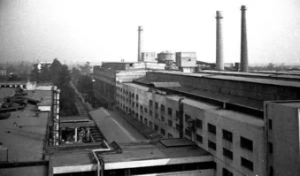
Hongguang Electron Tube Factory in 1960s
Since late 1970s, the transformation of China’s planned economy to socialist market economy along with 90s national policy of developing cultural industry called for a restructuring of state-owned manufacturing factories. In the case of the Hongguang Electron Tube Factory in Chengdu, in 2003, the factory was acquired by a local private enterprise, and was officially closed while some industrial buildings remain onsite.
Cultural integration: the development of CCI in urban redevelopment
The industrial zone in Chengdu’s eastern suburbs, as the earliest and largest industrial concentrated development zone in southwest China, witnessed the development of regional industrial modernisation during the Mao era. During the economic and cultural reforms, the national call for economic restructure in cities since late 70s and the CCI promotion campaign since 90s have jointly accelerated the decline of some manufacturing industries based in urban suburbs.
In China, the economic development of a city is regarded as an essential sign of urban (re)development achievement and the development result can be closely linked to the promotion opportunity of local political leaders. Under such circumstances, during this transformation period, local authorities like to put CCI related urban projects into their urbanisation master plan, trying to demonstrate that the city is economically competitive with this new industry. With manufacturing factories being relocated in subordinate counties or towns, those old factories in urban suburbs became only abandoned buildings carrying collective memory of a generation locally.
In the case of Chengdu, in response to the Sichuan Provincial Government’s guidance that cities are encouraged to follow a CCI oriented development path, the relocation of the large eastern industrial zone and the later redevelopment of this area became top two tasks in its urbanisation plan.
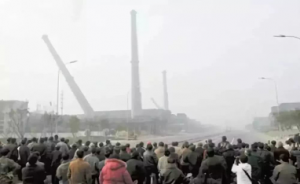
People gather to watch one factory demolishment in eastern suburb of Chengdu
In 2009, the Chengdu Municipal Committee and the Municipal Government gave the task of renovating the old Hongguang Electron Tube Factory to Chengdu Media Group, asking this project to realise a local music-related cultural hub following a heritage-preserved redevelopment strategy. Under this guidance, the CCI cluster Eastern Suburb Memory Park, with music at its core, was built on the original factory site, and was officially opened to the public on September 29, 2011. During the renovation of Eastern Suburb Memory Park, the space transformation experience in the Ruhr area of Germany were referenced, while the original 1950s architecture style, factory buildings, simple interior decorations and a large number of industrial equipment and facilities were also completely preserved: the Locomotive Square at the entrance was originally a logistics platform used by the original Hongguang factory to transport materials, and now this space retains one of the factory’s first batches of steam locomotives in Sichuan Province, and has now been transformed into a cafe; The large factory workshop was transformed into a theatre; a hydrogen tank was built into a large audio-visual space that can be rented out to the public; the previous workshop with multiple inter-layers and pipes has been turned into an art exhibition centre; the unique area surrounded by huge industrial structures such as chimneys, conveyor belts, boilers, pipe racks, etc. have become a distinctive music industry incubation platform in Chengdu’s east suburb area attracting small and medium sized music companies.

Entrance of Eastern Suburb Memory Park
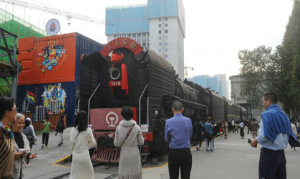
The Locomotive Square
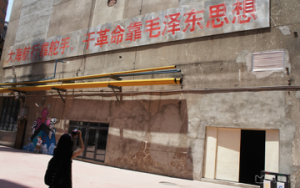
1960s slogans in Eastern Suburb Memory Park
The industrial production slogans, with planned economy era characteristics in the 1960s, are also retained in the park. The protection of the era-specific memory was considered in each part of space transformation, and reasonable repairs and improvements were made on this basis to preserve the original industrial relic to the best.
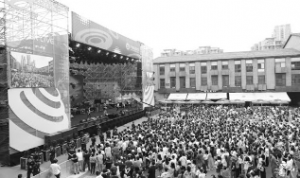
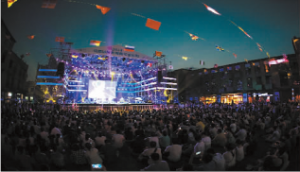
Annual music festival in Eastern Suburb Memory Park
As a typical representative of urban redevelopment project carrying the cultural industry elements and the traces of industrial civilisation in urbanisation history, the Eastern Suburb Memory Park stands out as one early development case in southwest China, following the CCI oriented and heritage-led urban (re)development strategy, through reuse of urban cultures in early 2000s.
Relying on the advantageous resources of Chengdu Media Group and its own physical conditions, the Eastern Suburb Memory Music Park vigorously introduces, develops and holds various cultural activities with brand and influence, providing comprehensive innovation, entrepreneurship and incubation services through community-based operation model under the guidance of accelerating the development of provincial and municipal music industry. Until 2018, as a local music industry cluster, Eastern Suburb Memory has won several national level awards including the “National Music Industry Base”, “National AAAA-level Tourism Scenic Spot”, “National Cultural Industry Demonstration Base”, “National Cultural and Technological Integration Demonstration Base”, “First batch of Press Publication Industry Demonstration Project”, and “National Industrial Heritage Tourism Base”. From a landmark of local industrial civilisation to a cultural and creative hub at national level, Eastern Suburb Memory Park is a dynamic place where modern CCI is being developed and urban collective memory can be revisited.
Mengran Zhu is a 2nd year graduate student in the School of Architecture and Cities in Westminster. She is currently doing research on China’s culture and creative industry led urban (re)development in second tier/medium sized cities. Her study interest lies in the development of China’s urban art districts, and she is constantly exploring the government-society relationship within this urban space
- TV Drama Discourse on Stay-at-home Fathers in China: Super Dad & Super Kids - January 28, 2022
- Freud and China - January 20, 2022
- “Cultural China 2020″—A Different Take on China - January 7, 2022
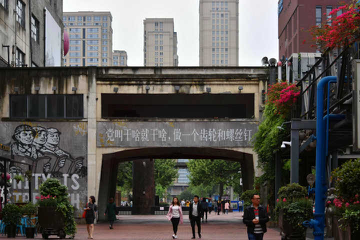
[…] fourth piece engages the same topic but with a slightly different focus. Mengran Zhu explores the place of urban memory within urban regeneration projects in city centres across […]